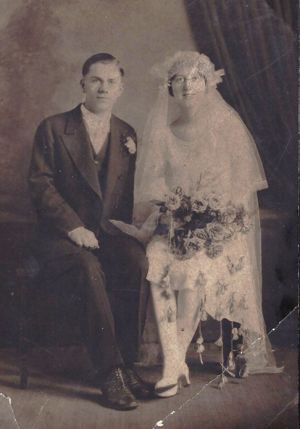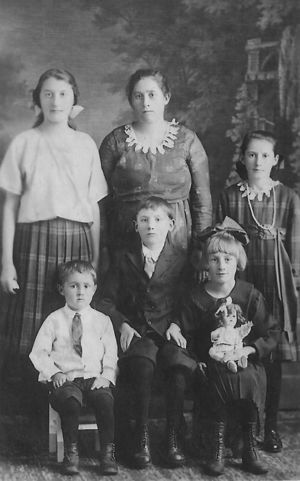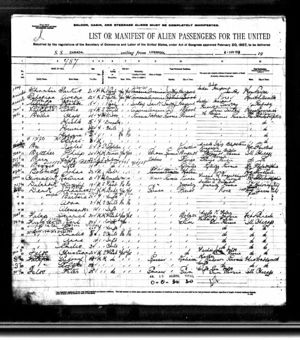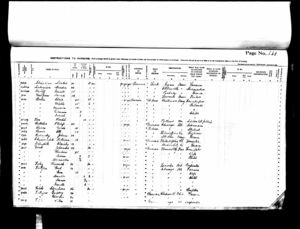Contents |
Biography
mtDNA Haplogroup H1af
Birth Date and Place
- 16 December 1907
- Grimm, Saratov, Russia
Parents
Marriage
- Alexander Kaiser
- 01 May 1926
- Fond du Lac, Wisconsin, United States
Children
- Robert Kenneth Kaiser
- [[Kaiser-1025|Ruth (Kaiser) Miller
Death Date and Place
- 9 December 1976
- Santa Ana, Orange County, California, United States
Amalia "Mollie" Fritzler was born in Grimm, Russia, on December 16, 1907, to Karl Fritzler and his wife Eva Kraft Schott. For the first five years of her life, she lived in the in the Russian Steppes near the Volga River. She was part of a group of Germans whose ancestors had immigrated to Russia after 1765, when Catherine the Great issued her manifest, inviting people to immigrate to her country.
Her father Karl Fritzler was a fourth generation Volga German, born in Grimm on February 28, 1880 to Johann Jakob Fritzler and Katharina Elisabeth Schaefer. The Fritzlers were descendants of Hanns Jakob Bauer Fritzler, born in 1688 in Kleingartach, Neckarkreis, Wurttemberg, Germany. His son Hannss Jakob Fritzler and his wife Franziska Catherina Eurich and their children were among the original settlers of Grimm in 1767. Both families were considered Evangelical, as opposed to Catholic, although the Colony of Grimm was considered a Reformed Protestant settlement.
Her mother was Eva Kraft Schott, born September 18, 1886, also in Grimm, to Johann Friedrich Schott and Eva Katharina Kraft. She was descended from Jakob Schott and Anna Margaretha Becker, and Adam and Susannah Kraft, four of the first settlers of Grimm. The Krafts were also Evangelical from Mittelbrunn, Pflaz, Bayern, Germany, and the Schotts were from Evangelisch, Holzgerlingen, Neckarkreis, Wuerttemberg.
Volga Germans lived a difficult life which did not resemble the original descriptions and promises of Catherine the Great. By the late 1800s, Volga German families began to immigrate to the United States and Canada, looking for a better life. Encouraged by the safe travels and good fortune of friends and relatives who immigrated, Mollie's father began to plan a move for his own family. His plans were delayed when he was drafted into the Tsar's Army, which, in turn, only made his urge to leave Russia stronger. Volga Germans were pacifists and had been promised no conscription by Catherine the Great. A century later, the ruling Russians backed out of that promise and regularly called up Volga Germans into their Army. Somehow Mollie's father managed to get a plum job as a guard for the Tsar, avoiding the dangerous battle fronts. At the conclusion of his service, he finalized his plans to leave Russia.
Mollie and her family began their journey along with her Aunt Mollie Fritzler Schneider, her Uncle Phillip Schneider, and their family, leaving Russia at the end of 1912. Mollie, the oldest of the children, was just five years old at the time they embarked on their journey, and she had two younger sisters, Amelia and Ann. According to the passenger manifest, Ann was an infant.
First they traveled by train from Saratov to Libau, Latvia, which at the time was territory of Russia. The trip to Libau took about two weeks. From there, a small ship took them on the first part of their ocean voyage from the European mainland to the eastern coast of England. About two weeks later, they traveled from Liverpool, England, to Halifax, Nova Scotia, Canada on the S.S. Canada. The passenger manifest for their ship confirms the families travel along with other relatives and friends.[1]
Years later, Mollie's Uncle Phillip recalled their journey to America for his daughter Frieda Schneider Grotegut and granddaughter Janelle Zimmermann. Janelle recorded the conversation on a cassette tape and transcribed the tape for her private use. A DNA match between the Janelle and me (Julie Miller Mangano) allowed us to connect and led to her generously sharing the information she had from her mother and grandparents.
One note from her taped conversation with Phillip read, "He [Phillip] came to America leaving Grimm, Russia on November 27, 1912 and reached America January 13, 1913. They left by railroad to Libau, Finland." [2]
To my knowledge, Libau is a Latvian city. I double checked to make sure there wasn't another Libau in Finland; there was not. If they traveled to Libau, they traveled to Western Latvia. I thought it was curious that Phillip mentioned Finland at all, since the country is in an entirely different direction from Latvia.
From Libau, the families took a small ship to Kingston upon Hull, Yorkshire, England, commonly referred to as Hull. This was the first time I had heard the town mentioned in connection with my family's history, so I decided to find out what ships sailed there from European ports. There were two shipping lines that provided passenger service:
- The Wilson Line of Hull, England
- F.A.A., an acronym for the Finnish Steamship Company
The Wilson Line mainly transported passengers between Norway and England. F.A.A. transported passengers from Helsinki and Libau to Hull. Because Phillip Schneider clearly mentioned Finland in his story about his journey to America, I believe that he meant they boarded a Finnish ship, not that they actually traveled to Finland before heading south and west.
Wikipedia shows the Finnish Steamship Company, Finska Ångfartygs Aktiebolag, was also known as F.A.A. [3] Their ship, the S.S. Titania, was primarily used to transport emigres from Finland to Hull. It made stops along the way in Libau and Copenhagen, picking up and transporting Russians and Jewish Latvians, too. [4]
I searched for a copy of the F.A.A. passenger lists from 1912. Copies of the passenger lists up to 1910 and after 1918 exist; the lists for passengers traveling between those years are either not available or were destroyed. [5]
According to the Genealogical Society of Finland, while some ships traveled from Helsinki to Hull, some ships carried Russians directly from Libau to Hull. "Apart from Finns, the volumes record thousands of Russians, a number of Estonians, Latvians and Livonians. Many of the Russians have Jewish names, but even German names are common...It is unclear whether all Russian emigrants travelled by way of Hanko, since F.Å.A. boats carried Russian emigrants from Libau to Hull without calling at a Finnish port." [6] (emphasis added)
According to Phillip Schneider, the journey on the S.S. Titania from Libau to Hull took four days, which means the two families arrived in England about December 15-18, 1912. The ship docked at the Riverside Quay, a dock built specifically to handle quick turnaround ocean vessel traffic at the port. A rail station adjoined the quay, allowing European travelers to conveniently board a train that took them to Liverpool where they would board larger ocean liners that headed to America.
The Fritzlers and the Schneiders spent 17-19 days in England prior to boarding the S.S. Canada. Some of that time may have been spent traveling. It's unclear whether the families were able to take a train directly to Liverpool or if they traveled south to London and then northwest to the port city.
According to historical records, once the passengers arrived in Liverpool, they were not allowed to board outbound ships until the day before or the day of departure. If they arrived earlier than that, they were forced to stay in a lodging house. Historically, the lodging houses had a reputation for being crowded and unsanitary. [7] By the turn of the 20th century, often the steamship companies looked after the emigrants during their stay, putting them up in company-owned lodges. [8] Although conditions in the early 1900s were better than those 30-50 years earlier, there were still complaints. It's difficult to imagine which was worse: lodging accommodations in the port city or steerage class on board a ship. Knowing this makes it clear how horrible the conditions in their homeland must have been, for all the Volga Germans to be willing to uproot their families and endure the long, uncomfortable journey to America.
After the families spent more a couple of weeks in a lodging house, they boarded their ship and departed for America on January 4, 1913. The voyage across the Atlantic normally took 10-11 days. Some ships traveling across the Atlantic made a stop in Ireland to pick up additional passengers. Since the S.S. Canada made the voyage in only 9 days, it probably bypassed Ireland and headed straight to America, reaching Nova Scotia, Canada on January 13, 1913.
Mollie's uncle remembered what the families paid for tickets on the steamers: $150 per adult, $75 per child, and $8 for an infant son under two years of age. Most likely they traveled 3rd class or steerage, and they brought plenty of black bread and sausage from home for the journey. Phillip recalled that the ship meals included bear meat and fish, among other things, and that, frankly, the food wasn't very tasty. Even with dipping in to their personal food supply, the families still managed to make their bread and sausage last more than a month, until shortly before they arrived in Chicago. [9]
The ship landed in Nova Scotia, Canada. Passengers going to the United States were transported over the border where they were processed in Portland, Maine. From there the families took a train to Chicago where they stayed with two different families. Karl and his family stayed with the Ahlbrandts, and the Schneiders stayed with Herman Schuette, Phillip's cousin.
The following account of Mollie's life in the United States was written by her daughter, Ruth Kaiser Miller.
"My mother was the oldest of five children. Her family heritage was actually German, but they had lived in Russia for four or five generations. After her family immigrated to the U.S. from Grimm, Russia, they lived in Windsor, Colorado, a small farming town. The older children, including Mollie, had to help working in the sugar beet fields on nearby farms to help support their families. It was back-breaking work in the hot sun. After a few years they moved to Fond du Lac, Wisconsin, where many of their German friends lived. There my grandfather worked in the nearby Fred Rueping Leather Co. and they lived in a little house. Before long, they bought their own roomy home in the center of town.
"My mother met a handsome young man who lived three blocks away from her home. He was from Grimm, Russia and their families were acquainted. This young man, named Alex Kaiser, and my mother were married when she was only 18 years old. My mother was not an outgoing person but Alex was a very smart 21-year-old and a go-getter. He worked in the office of Rueping Leather Co. and in a few years became a salesman, traveling around the state selling leather. He was very successful. They moved to Chicago for a while where my brother was born. Then they moved to Milwaukee where I was born five years later.
"When I was three years old, we moved into a brand new brick, two story home, where my mother was in her glory taking care of it in every way. She was very happy being at home, taking care of her family, and never having to work outside of the home. Social life consisted of Church and many friends whom they quickly met. I remember many parties they had, usually ending up in our basement recreation room playing ping pong and other fun games.
"Like many women of that time, mother was an excellent knitter and also did crocheting. She knit me a number of sweaters, the favorite of mine being a heavy, bright green turtleneck sweater with matching socks. I wore this sweater mainly when I went ice skating in a nearby park, and I was very proud of it. She also did some sewing, but was never as proficient as her own mother with the sewing needle. She was also an excellent baker and chef. She made her own noodles and hung them over the backs of chairs to dry.
"My father was transferred to St, Louis, but we stayed living in Milwaukee. Every Friday night Dad would fly to Chicago, and then take the train to Milwaukee and be home for the weekend. I would ride along with my mother to the railroad station down town every Friday night around 9:00 p.m. to pick up Dad. He was home for the weekend, and then went back to St. Louis early Monday morning. I realize now it must have been very lonely for my mom, being at home with two kids, without her husband during the week.
"Mother enjoyed reading, and she also was a student of the Bible. She could recite so many Bible verses by heart. She set a good example for me, but she was never pushy. I don't remember her losing her temper, but I suppose she kept some things inside."
As remembered by Ruth Kaiser Miller, Mollie Fritzler Kaiser's daughter.
Sources
- ↑ U.S., Atlantic Ports Passenger Lists, 1820-1873 and 1893-1959; Author: Ancestry.com; Publisher: Ancestry.com Operations Inc., Provo, UT, USA; Publisher Date: 2010.
- ↑ Email from Dean Zimmermann, son of Janelle Zimmermann, which included notes from a conversation with Phillip Schneider.
- ↑ https://en.wikipedia.org/wiki/Finland_Steamship_Company
- ↑ www dot genealogia dot fi / emi / emi321ne dot htm
- ↑ http://www.liverpoolmuseums.org.uk/maritime/archive/sheet/64
- ↑ www dot genealogia dot fi / emi / emi321ne dot htm
- ↑ http://www.norwayheritage.com/articles/templates/voyages.asp?articleid=28&zoneid=6.
- ↑ http://www.liverpoolmuseums.org.uk/maritime/archive/sheet/64.
- ↑ Email from Dean Zimmermann, son of Janelle Zimmermann, which included notes from a conversation with Phillip Schneider.
See also:
- U.S., Atlantic Ports Passenger Lists, 1820-1873 and 1893-1959; Author: Ancestry.com; Publisher: Ancestry.com Operations Inc., Provo, UT, USA; Publisher Date: 2010.
- 1920 United States Federal Census, Year: 1920; Census Place: Fond du Lac Ward 14, Fond du Lac, Wisconsin; Roll: T625_1986; Page: 4A; Enumeration District: 43; Image: 961, by Ancestry.com, Ancestry.com Operations Inc., Provo, UT, USA, 2010.
- 1930 United States Federal Census; Year: 1930; Census Place: Milwaukee, Milwaukee, Wisconsin; Roll: 2595; Page: 35A; Enumeration District: 0258; Image: 185.0; FHL microfilm: 2342329; Source: Ancestry.com; Author: Ancestry.com; Publisher: Ancestry.com Operations Inc., Provo, UT, USA; Publisher Date: 2002
- Mollie Kaiser's Death Certificate
- New York, Passenger Lists, 1820-1957, Year: 1911; Arrival: New York, New York; Microfilm Serial: T715, 1897-1957; Microfilm Roll: Roll 1629; Line: 22; Page Number: 203, by Ancestry.com, Ancestry.com Operations, Inc., Provo, UT, USA, 2010
- U.S., Social Security Death Index, 1935-2014, U.S., Social Security Death Index, 1935-Current, by Ancestry.com, Ancestry.com Operations Inc., Provo, UT, USA, 2011
- Notes and family papers from Phillip Schneider, Mollie Fritzler Schneider, and their daughter Frieda Schneider Grotegut. Original copies are with Frieda's daughter Janelle Zimmermann.
- Miller, Ruth Kaiser, daughter of Mollie Fritzler Kaiser, personal stories and recollections regarding the Fritzler family
Memories: 1
It may be possible to confirm family relationships. It is likely that these autosomal DNA test-takers will share some percentage of DNA with Mollie:
-
~25.00%
 ~25.00%
Julie (Miller) Mangano
~25.00%
Julie (Miller) Mangano  :
23andMe, GEDmatch M763404 [compare] [compare x]
+
AncestryDNA, GEDmatch A046972 [compare] [compare x], Ancestry member juliemangano2008
:
23andMe, GEDmatch M763404 [compare] [compare x]
+
AncestryDNA, GEDmatch A046972 [compare] [compare x], Ancestry member juliemangano2008
This week's featured connections are Exercise Gurus: Mollie is 22 degrees from Richard Simmons, 27 degrees from Billy Blanks, 23 degrees from John Dunlop, 19 degrees from Jack LaLanne, 23 degrees from Pehr Henric Ling, 29 degrees from Davina McCall, 19 degrees from R. Tait McKenzie, 23 degrees from Olivia Newton-John, 23 degrees from William Orban, 21 degrees from Arnold Schwarzenegger, 20 degrees from Suzanne Somers and 19 degrees from Raquel Welch on our single family tree. Login to see how you relate to 33 million family members.
F > Fritzler | K > Kaiser > Amalia (Fritzler) Kaiser
Categories: Grimm | Fond du Lac, Wisconsin | Milwaukee, Wisconsin | Estabrooks Cemetery, Fond du Lac, Wisconsin | Migrants from Saratov Governorate to Wisconsin | German Roots






She came to the United States from Russia as a young child. According to her naturalization papers, she came to America on the S.S. Kaldesberg as a third class passenger. The ship departed from Libau via Liverpool and arrived in Portland, Maine on January 15, 1913. Her original ticket was purchased in Saratov, Russia.
She never finished high school. When she was old enough, she worked at a sugar beet factory near Denver, Colorado to help her family make ends meet. She and her two sisters harvested the beets or worked in the processing plant.
Her parents moved their family to Fond du Lac, Wisconsin in the early 1920s. It was there that she met her future husband, Alex Kaiser, another young man originally from Grimm, Russia. They married on May 1, 1926 in Fond du Lac.